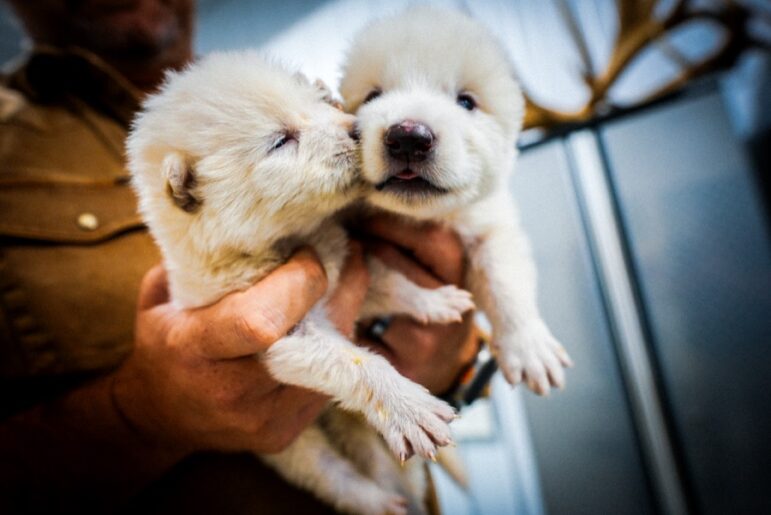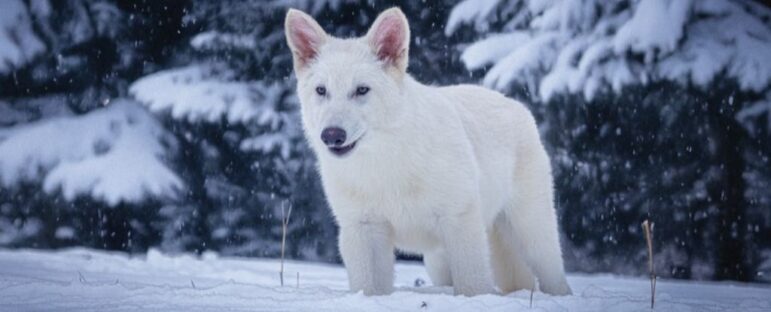DALLAS – The Paganosphere has been abuzz with excitement over recent headlines claiming that dire wolves—legendary beasts of Ice Age lore and pop culture fame—are back. The announcement by Colossal Biosciences, a Dallas-based biotech company, stirred both fascination and controversy. But while the news sounds like something out of a Michael Crichton novel, the reality is just a bit more complex.
First, a quick recap: Aenocyon dirus, the dire wolf, roamed North and South America during the Late Pleistocene epoch, roughly 250,000 to 10,000 years ago. They were larger and more heavily built than modern gray wolves, with strong jaws designed for bone-crushing bites. Fossils found in sites like the La Brea Tar Pits suggest they hunted in packs and preyed on large herbivores such as bison and prehistoric horses.
What makes dire wolves particularly fascinating to scientists is their evolutionary uniqueness. Long thought to be close relatives of the gray wolf (Canis lupus), recent genetic research has revealed that dire wolves were actually part of a much older lineage, having diverged from other canines nearly six million years ago. This discovery has rewritten aspects of the canine family tree and deepened our understanding of prehistoric ecosystems.
Outside of science, dire wolves have long held a powerful place in the cultural imagination. They gained mainstream popularity through HBO’s Game of Thrones, where they served as massive, loyal companions to the Stark children. Fantasy fans also know them from Dungeons & Dragons, where dire wolves appear as larger, more savage versions of regular wolves—ideal threats for low- to mid-level adventurers.
Even in The Lord of the Rings, although the name “dire wolf” is never used, Tolkien’s wargs fill a similar role: enormous wolves- in this case evil ones- that rampage with Orcs and evoke ancient, mythic fear. Tolkien drew inspiration from Norse mythology, where monstrous wolves like Fenrir -who plays a pivotal role in the events of Ragnarök, where he is prophesied to help ignite the world in flames, leading to the downfall of humanity and the end of civilization – are common, and the word “warg” itself derives from the Old Norse vargr, meaning both “wolf” and “destroyer.”

The terrifying puppies of a genetically engineered gray wolf. (Courtesy: Colossal Biosciences)
So when Colossal Biosciences claimed on October 1, 2024, to have successfully “revived” the dire wolf, it’s no surprise that fans of science and fiction alike took notice. The company announced the birth of three genetically engineered gray wolf pups—named Romulus, Remus, and Kaleesi—as the first living representatives of the extinct predator. “Colossal successfully restored a once-eradicated species through the science of de-extinction,” the company’s press release declared.
For some of us, it raised hope that we might not need an asteroid after all, but rather three puppies just reaching maturity.
Colossal attributes its accomplishment to breakthroughs in genome editing, synthetic biology, and conservation science. According to their statement, the pups carry specific genetic traits identified in ancient dire wolf DNA, blended into the genome of modern gray wolves. The result, they say, is a hybrid that mimics the dire wolf’s form and behavior.
Some scientists have urged caution. Philip Seddon, a zoologist from the University of Otago in New Zealand, was quick to point out that the animals created by Colossal are, in essence, “genetically modified gray wolves.” The DNA extracted from real dire wolf fossils, while informative, is too degraded for direct cloning. Paleogeneticist Dr. Nic Rawlence, also from Otago, compared it to putting DNA in a “500-degree oven overnight”—the result is fragmented, dusty, and impossible to replicate fully.
Instead, researchers identified key markers in the dire wolf genome and edited those into a modern wolf’s DNA. “What Colossal has produced is a gray wolf with some dire wolf-like features—such as a larger skull and white fur,” Rawlence said. “It’s a hybrid.”
This nuance hasn’t stopped bold claims from being made, including the company’s assertion that they’re restoring the dire wolf to its “rightful place in the ecosystem.” That’s a bold vision, and one that critics say raises important questions. Biologist Jeremy Austin pointed out to ScienceAlert that the ecosystems dire wolves once occupied have long since vanished or changed drastically. “Is there even an ecological niche for dire wolves in today’s world?” he asks. “Or are they just zoo attractions people will pay to see and say, ‘Look, we saw a dire wolf,’ while I’m standing there saying, ‘No, you saw a white gray wolf.’”
Austin also takes issue with the way species identity is being defined. Evolutionary biologist Beth Shapiro offered a flexible interpretation: “If it looks like that species, if it acts like that species, if it’s fulfilling the ecological role of that species—then you’ve done it.” Austin, however, compared this approach to the tale of The Emperor’s New Clothes. “If you say you’ve done something, and enough people believe you, then, well—you’ve done it,” he said dryly. He worries that calling these hybrids “dire wolves” undermines scientific credibility.
Even Matt James, Colossal’s chief animal officer who oversaw the births, seemed swept up in the moment, telling The New York Times that he knew the project was a success the moment he saw one of the pups with a white coat. But Austin finds that troubling. “For a fully trained wolf biologist or evolutionary scientist to claim, ‘We have a dire wolf because it’s white,’ is cutting corners,” he said. “It brings the whole thing into disrepute.”
Nevertheless, skeptics acknowledge that the work being done at Colossal has real value—for conservation, for genetics, and for our understanding of evolutionary development. But calling these animals “dire wolves” may be more about marketing than scientific rigor.

Image via Colossal Biosciences
So, are the dire wolves truly back? Not exactly. What we have is a carefully engineered wolf hybrid, created with the help of ancient DNA, designed to resemble a creature that once roamed Ice Age plains. It’s a feat of biotechnology—and a fascinating intersection of myth, science, and imagination.
At least the Universe is filled with asteroids.
The Wild Hunt is not responsible for links to external content.
To join a conversation on this post:
Visit our The Wild Hunt subreddit! Point your favorite browser to https://www.reddit.com/r/The_Wild_Hunt_News/, then click “JOIN”. Make sure to click the bell, too, to be notified of new articles posted to our subreddit.